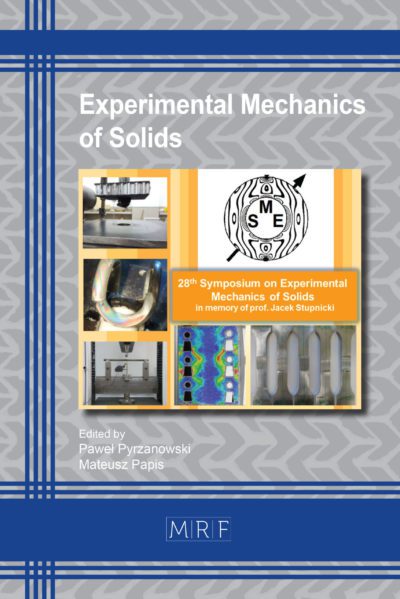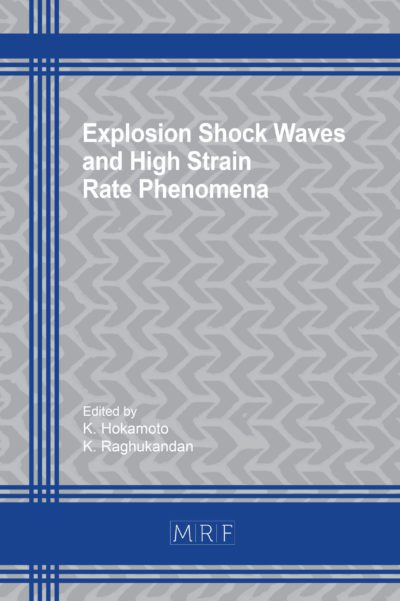Microstructural and defects investigation of AlCrFeMnNi-based high entropy alloy fabricated via laser powder bed fusion
Abdul Herrim Seidou, Catherine Blondiau, Olivier Dedry, Jérôme Tchoufang Tchuindjang, Anne Mertens
Abstract. Al0.15CrFe2.9Mn1.7Ni2.1Mo0.2 high entropy alloy (HEA) powder’s mixture was prepared manually by blending 316L stainless steel with elemental powders. The mixture was processed through Laser Powder Bed Fusion (LPBF) to achieve a face-centered cubic (FCC) structure, aiming to enhance corrosion resistance. Since the powders used were not designed for LPBF, this study investigates the effects of powder characteristics and scanning strategies on the resulting microstructure with a focus on the defects assessment. After optimizing the processing parameter window through single tracks printing, the scanning strategy is selected while varying laser power, scanning speed and remelting step. Microstructure analysis of the printed samples was conducted by combining Optical Microscopy (OM) and Scanning Electron Microscopy (SEM). The analysis revealed the presence of hot cracks and unmelted agglomerates of refractory elements, and other compositional heterogeneities in all the samples. The findings provide a basis for developing optimized printing strategies and producing defects-free printed samples.
Keywords
Additive Manufacturing, Laser Powder Bed Fusion, High Entropy Alloys, Defects, Microstructure
Published online 5/7/2025, 11 pages
Copyright © 2025 by the author(s)
Published under license by Materials Research Forum LLC., Millersville PA, USA
Citation: Abdul Herrim Seidou, Catherine Blondiau, Olivier Dedry, Jérôme Tchoufang Tchuindjang, Anne Mertens, Microstructural and defects investigation of AlCrFeMnNi-based high entropy alloy fabricated via laser powder bed fusion, Materials Research Proceedings, Vol. 54, pp 159-169, 2025
DOI: https://doi.org/10.21741/9781644903599-18
The article was published as article 18 of the book Material Forming
![]() Content from this work may be used under the terms of the Creative Commons Attribution 3.0 license. Any further distribution of this work must maintain attribution to the author(s) and the title of the work, journal citation and DOI.
Content from this work may be used under the terms of the Creative Commons Attribution 3.0 license. Any further distribution of this work must maintain attribution to the author(s) and the title of the work, journal citation and DOI.
References
[1] I. Yadroitsev, I. Yadroitsava, A. du Plessis, E. MacDonald, Fundamentals of laser powder bed fusion of metals, first ed., Elsevier, 2021. https://doi.org/10.1016/B978-0-12-824090-8.00024-X
[2] A. T. Sutton, C. S. Kriewall, M. C. Leu, J.W. Newkirk, Powder characterisation techniques and effects of powder characteristics on part properties in powder-bed fusion processes, Virtual Phys. Prototyp., 12(1) (2017) 3-29. https://doi.org/10.1080/17452759.2016.1250605
[3] J. Wang, R. Zhu, Y. Liu, L. Zhang, Understanding melt pool characteristics in laser powder bed fusion: An overview of single-and multi-track melt pools for process optimization, APM, 2(4) (2023), 100137. https://doi.org/10.1016/j.apmate.2023.100137
[4] Y. Liu, Z. Liu, Y. Jiang, G. Wang, Y. Yang, L. Zhang, Gradient in microstructure and mechanical property of selective laser melted AlSi10Mg, J. Alloy. Comp.735 (2018) 1414-1421. https://doi.org/10.1016/j.jallcom.2017.11.020
[5] N.T. Aboulkhair, N.M. Everitt, I. Ashcroft, C. Tuck, Reducing pore in AlSi10Mg parts processed by selective laser melting, Addit. manuf. 1-4 (2014) 77-86. https://doi.org/10.1016/j.addma.2014.08.001
[6] H. Li, E. G. Brodie, C. Hutchinson, Predicting the chemical homogeneity in laser powder bed fusion (LPBF) of mixed powders after remelting, Addit. Manuf., 65 (2023) 103447. https://doi.org/10.1016/j.addma.2023.103447
[7] L. Guo, J. Gu, B. Gan, S. Ni, Z. Bi, Z. Wang, M. Song, Effects of elemental segregation and scanning strategy on the mechanical properties and hot cracking of a selective laser melted FeCoCrNiMn-(N, Si) high entropy alloy, J. Alloys Compd., 865 (2021) 158892. https://doi.org/10.1016/j.jallcom.2021.158892
[8] J.W. Yeh, S.K. Chen, S.J. Lin, J.Y. Gan, T.S. Chin, T.T. Shun, S.H. Tsau, S.Y. Chang, Nanostructured high-entropy alloys with multiple principal elements: novel alloy design concepts and outcomes, Adv. Eng. Mater. 6 (2004) 299-303. https://doi.org/10.1002/adem.200300567 https://doi.org/10.1002/adem.200300567
[9] B. Cantor, I.T.H. Chang, P. Knight, A.J.B. Vincent, Microstructural development in equiatomic multicomponent alloys, Mater. Sci. Eng. 375-377 (2004) 213-218. https://doi.org/10.1016/j.msea.2003.10.257
[10] Y. Zhang, T.T. Zuo, Z. Tang, M.C. Gao, K.A. Dahmen, P.K. Liaw, Z.P. Lu, Microstructures and properties of high-entropy alloys, Prog. Mater Sci. 61 (2014) 1-93. https://doi.org/10.1016/j.pmatsci.2013.10.001
[11] D.B. Miracle, O.N. Senkov, A critical review of high entropy alloys and related concepts, Acta Mater. 122 (2017) 448-511. https://doi.org/10.1016/j.actamat.2016.08.081 https://doi.org/10.1016/j.actamat.2016.08.081
[12] Y. Shi, B. Yang, P.K. Liaw, Corrosion-resistant high-entropy alloys: A review, Metals 7 (2017). https://doi.org/10.3390/met7020043 https://doi.org/10.3390/met7020043
[13] A. Giorgetti, N. Baldi, M. Palladino, F. Ceccanti, G. Arcidiacono, P. Citti, A Method to Optimize Parameters Development in L-PBF Based on Single and Multitracks Analysis: A Case Study on Inconel 718 Alloy, Metals, 13 (2) (2023). https://doi.org/10.3390/met13020306 https://doi.org/10.3390/met13020306
[14] R. Saluja, K. M. Moeed, The emphasis of phase transformations and alloying constituents on hot cracking susceptibility of type 304L and 316L stainless steel welds, Int. J. Eng. Sci. Technol., 4(5) (2012) 2206-2216.
[15] L. Shoji Aota, P. Bajaj, H. R. Zschommler Sandim, E. Aimé Jägle, Laser powder-bed fusion as an alloy development tool: Parameter selection for in-situ alloying using elemental powders, Materials, 13(18) (2020) 3922. https://doi.org/10.3390/ma13183922
[16] H. Li, E. G. Brodie, C. Hutchinson, Predicting the chemical homogeneity in laser powder bed fusion (LPBF) of mixed powders after remelting, Addit. Manuf., 65 (2023) 103447. https://doi.org/10.1016/j.addma.2023.103447
[17] T. Zhang, H. Li, S. Liu, S. Shen, H. Xie, W. Shi, G. Zhang, B. Shen, L. Chen, B. Xiao, M. Wei, Evolution of molten pool during selective laser melting of Ti-6Al-4V, J. Phys. D Appl. Phys. 59 (2019) 055302. https://doi.org/10.1088/1361-6463/aaee04
[18] D. Tomus, P.A. Rometsch, M. Heilmaier, X. Wu, Effect of minor alloying elements on crack-formation characteristics of Hastelloy-X manufactured by selective laser melting, Addit. Manuf. 16 (2017) 65-72. https://doi.org/10.1016/j.addma.2017.05.006
[19] A. Hariharan, L. Lu, J. Risse, A. Kostka, B. Gault, E.A. Jägle, D. Raabe, Misorientation-dependent solute enrichment at interfaces and its contribution to defect formation mechanisms during laser additive manufacturing of superalloys, Phys. Rev. Mater. 3 (12) (2019) 123602. https://doi.org/10.1103/PhysRevMaterials.3.123602
[20] J. Li, S.L. Shrestha, Y. Long, L. Zhijun, Z. Xintai, The formation of eutectic phases and hot cracks in one Ni-Mo-Cr superalloy, Mater. Des., 93 (2016) 324-333. https://doi.org/10.1016/j.matdes.2015.12.152
[21] L. Guo, J. Gu, B. Gan, S. Ni, Z. Bi, Z. Wang, M. Song, Effects of elemental segregation and scanning strategy on the mechanical properties and hot cracking of a selective laser melted FeCoCrNiMn-(N, Si) high entropy alloy, J. Alloys Compd., 865 (2021) 158892. https://doi.org/10.1016/j.jallcom.2021.158892
[22] R. Engeli, T. Etter, S. Hövel, and K.Wegener, Processability of different IN738LC powder batches by selective laser melting, J. Mater. Process. Technol., 229 (2016) 484. https://doi.org/10.1016/j.jmatprotec.2015.09.046
[23] P. Agrawal, S. Thapliyal, P. Agrawal, A. Dhal, R. S. Haridas, S. Gupta, R. S. Mishra, Additive manufacturing of a metastable high entropy alloy: Metastability engineered microstructural control via process variable driven elemental segregation, Mater. Sci. Eng., A 872 (2023) 144938. https://doi.org/10.1016/j.msea.2023.144938
[24] Z. Sun, X. P. Tan, M. Descoins, D. Mangelinck, S. B. Tor, C. S. Lim, Revealing hot tearing mechanism for an additively manufactured high-entropy alloy via selective laser melting, Scr. Mater., 168 (2019) 129-133. https://doi.org/10.1016/j.scriptamat.2019.04.036
[25] E. G. Brodie, E, J. Richter, T. Wegener, T. Niendorf, A. Molotnikov, Low-cycle fatigue performance of remelted laser powder bed fusion (L-PBF) biomedical Ti25Ta, Mater. Sci. Eng., A 798 (2020) 140228. https://doi.org/10.1016/j.msea.2020.140228
[26] Z. Xiao, C. Chen, Z. Hu, H. Zhu, H, X. Zeng, Effect of rescanning cycles on the characteristics of selective laser melting of Ti6Al4V, Opt. Laser Technol., 122 (2020) 105890. https://doi.org/10.1016/j.optlastec.2019.105890
[27] H. Ali, H. Ghadbeigi, K. Mumtaz, Effect of scanning strategies on residual stress and mechanical properties of Selective Laser Melted Ti6Al4V, Mater. Sci. Eng., A 712 (2018) 175-187. https://doi.org/10.1016/j.msea.2017.11.103
[28] Z. Xiong, P. Zhang, C. Tan, D. Dong, W. Ma, K. Yu, Selective laser melting and remelting of pure tungsten, Adv. Eng. Mater., 22(3) (2020) 1901352. https://doi.org/10.1002/adem.201901352
[29] L. N. Carter, C. Martin, P. J. Withers, M. M. Attallah, The influence of the laser scan strategy on grain structure and cracking behaviour in SLM powder-bed fabricated nickel superalloy, J. Alloys Compd., 615 (2014) 338-347. https://doi.org/10.1016/j.jallcom.2014.06.172














